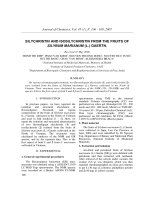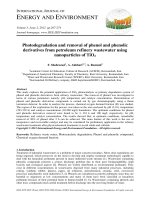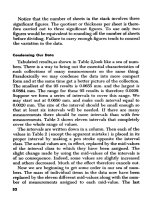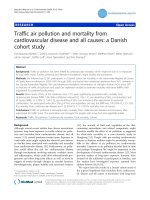Dose Calculation and Measurement from B10(n, α)Li7 Reaction Using Filtered Neutron Beam at Nuclear Research Institute
Bạn đang xem bản rút gọn của tài liệu. Xem và tải ngay bản đầy đủ của tài liệu tại đây (417.62 KB, 7 trang )
Nuclear Science and Technology, Vol.8, No. 1 (2018), pp. 29-35
Dose Calculation and Measurement from B10(n, α)Li7 Reaction
Using Filtered Neutron Beam at Nuclear Research Institute
Trinh Thi Tu Anh1, Nguyen Danh Hung1, Pham Dang Quyet1, Pham Ngoc Son2
1
2
Dalat University, 01 Phu Dong Thien Vuong Street, Dalat, LamDong, Vietnam
Nuclear Research Institute, 01 Nguyen Tu Luc Street, Dalat, LamDong, Vietnam
Email:
(Received 20 March 2018, accepted 14 May 2018)
Abstract: In this research, dose calculation and measurement from B 10 (n, α) Li7 reaction using
filtered neutron beam at the Nuclear Research Institute have been reported. Calculation was carried
out by Monte Carlo method using MCNP5 code. Neutron activation technique using vanadium foil
was employed to determine neutron flux at various positions in phantom from which neutron dose has
been calculated using conversion factor. These calculations are basics for the dose determination
research of the Boron Neutron Capture Therapy (BNCT) in Vietnam.
Keywords: Dose calculation, Monte Carlo, BNCT.
I. INTRODUCTION
Boron neutron capture therapy (BNCT)
is a promising treatment for malignant tumors
and has been studied in many advanced
countries. There are ongoing researches
worldwide relating to the utilization of neutron
beam in BNCT [1-3].
In Vietnam, however, BNCT has still
been a new field. The only 500kW nuclear
reactor in Vietnam cannot generate sufficient
epithermal neutrons for the BNCT; however,
thermal neutrons can be obtained by using
filtering system. These thermal neutrons can be
used for basic experiments in the BNCT before
real trials on living creatures. Besides, due to
the lack of research facilities in Vietnam,
simulation programs like MCNP will be
valuable tools in supporting the studies. The
combination of real experiments with
simulation will be the alternative method to the
development of the BCNT in Vietnam.
The main purpose of this research was to
calculate radiation dose in the BNCT for brain
tumors treatment using the simulation program
of MCNP. Besides, the feasibility of MCNP
program in simulating the neutron beam
utilized at the Nuclear Research Institute (NRI)
in Vietnam was also taken into consideration.
II. CONTENT
A. Subjects and methods
Neutron beam guide and neutron filter at
Channel 2 of Dalat nuclear reactor modeled in
MCNP were illustrated in Figure 1. The total
length of the cylindrical-shaped neutron beam
guide was 153cm; inner diameter was 9.4cm;
outer rim consisted of 2 parts linked firmly
together. The outer surface of the neutron beam
guide was wrapped by a 4mm layer of
Aluminum. The inner bottom was a 3cm thick
aluminum annulus to enable easy installation.
The outer surface of the annulus was threaded.
Its inner and outer diameters were 15cm and
6.5cm, respectively. The inner bottom of the
annulus not only guided the neutron but also
sealed the inner and outer surface, preventing
the filter‟s pin and collimator from sliding out
of the beam guide system. The outer bottom is
an aluminum ring with a thickness of 2.7cm,
©2018 Vietnam Atomic Energy Society and Vietnam Atomic Energy Institute
DOSE CALCULATION AND MEASUREMENT FROM B10(N, Α)LI7 REACTION …
outer diameter of 15cm, and inner diameter of
9.4cm. The filter includes Bismuth and Silicon
layers, with their thickness of 3 and 20cm,
respectively. After traversing the filter with
maximum length of 150cm, neutron beam was
collimated. The collimator involved layers of
materials, including: 3 layers of Lead with a
total length of 30cm, 5 layers of Borated +
Hydrogenated Concrete (SWX-277 contained
1.56% B) with a total length of 60cm. These
layers were set alternately together. At 30cm
away from the output gate of Channel 2, a
block of 7cm of stainless steel was added to
stop gamma radiation and ensure the watertight
of the channel [4].
Fig. 1. Structure of the neutron beam guide and neutron filter simulated by MCNP5.
Requirements for the neutron beam guide
of Channel 2: (i) Gamma and neutron dose rate
outside of the beam guide < 10 µSv/h; (ii)
Thermal neutron flux at the beam port ≥106
n/cm2/s; (iii) The output neutron flux had a cross
section diameter of 3cm; (iv) Reduction of
shielding outside the Channel and (v) Easy
assembly and disassembly mechanism.
In this research, the neutron flux was
determined at points distributed inside a water
phantom. This phantom was designed as a
rectangular plastic box, with its length, width
and depth being 25cm, 18cm and 16cm,
respectively. The upper surface of the phantom
was punctured with holes in an array form as
shown in Figure 2.
(a)
(b)
Fig. 2. (a) Phantom simulation, (b) The real phantom.
30
TRINH THI TU ANH et al.
Neutron flux was determined by the
activation method. The standard samples used
in this experiment were the round-shaped
Vanadium (Vu –Vt) foils with neutron
captured cross section of 4.75 barns, thickness
of 0.05 mm. The foil was attached to a 16cm
long stick which was inserted to the phantom
through holes on the top surface as illustrated
in Figure 2. The bottom of the stick was
attached with a lead cube to keep the foil stable
during the irradiation process. The irradiation
time was nearly 4 minutes. Afterwards, the foil
was removed from the phantom and measured
by an HPGe detector. The neutron flux was
then calculated from the radioactivity of the
irradiated foil. The process was repeated with
different positions of the foil within the
phantom. Based on international standards of
dose conversion coefficient for neutron flux,
the dose rate can be determined from neutron
flux measurements' results by multiplying by
the elemental neutron kerma (Gy.cm2) for
ICRU adult brain. Data for adult brain
component and neutron cross-section were
extracted from ICRU Report 63 [5] and
JENDL-3.2, respectively.
Table 1. Elemental Neutron Kerma (Gy.cm2) for ICRU Adult Brain.
Neutron
Energy
(MeV)
H1
C12
N14
O16
P31
S-Nat
Total
1,000E-10
7,163E-14
5,514E-17
2,746E-12
3,806E-18
2,220E-17
8,709E-17
2,848E-12
2,530E-08
4,503E-15
3,467E-18
1,726E-13
2,393E-19
1,396E-18
8,709E-17
1,791E-13
1,100E-07
2,193E-15
1,762E-18
8,370E-14
2,982E-19
6,640E-19
8,709E-17
8,689E-14
1,100E-06
8,044E-16
1,392E-18
2,651E-14
2,073E-18
2,120E-19
8,709E-17
2,769E-14
1,100E-05
1,369E-15
8,754E-18
8,370E-15
2,045E-17
1,064E-19
8,709E-17
9,933E-15
1,100E-04
1,155E-14
8,596E-17
2,651E-15
2,045E-16
4,080E-19
8,711E-17
1,459E-14
1,100E-03
1,144E-13
8,567E-16
1,027E-15
2,045E-15
3,492E-18
8,727E-17
1,184E-13
1,100E-02
1,069E-12
8,481E-15
1,906E-15
2,037E-14
4,200E-17
8,883E-17
1,100E-12
1,050E-01
6,739E-12
7,493E-14
8,502E-15
1,903E-13
2,232E-16
1,043E-16
7,013E-12
1,050E+00
2,235E-11
4,068E-13
4,535E-14
2,776E-12
1,488E-15
3,349E-16
2,558E-11
1,050E+01
4,899E-11
1,704E-12
4,031E-13
9,728E-12
3,668E-14
1,249E-14
6,089E-11
experiment results. This can be explained by
the fact that in simulation, the flux in small
cells was calculated instead of the flux at
points. Therefore, the difference between
simulation and measurement results was
insignificant and the simulation of neutron
beam generated from Channel 2 proved to
be valid.
B. Result and discussion
The total neutron flux at Channel 2
was 3.16x107 (n/cm2 .s), mainly consisting
of thermal neutrons [4]. The measured and
simulated thermal neutron flux distributions
along the beam port‟s axis were given in
Figure 3. As can be seen the Figure, there is
a little difference between simulation and
31
DOSE CALCULATION AND MEASUREMENT FROM B10(N, Α)LI7 REACTION …
Fig. 3. Experiment and simulation results of neutron flux on Oz axis.
just a few millimeters, insignificantly by
comparing to the radius of the beam port
(2cm). Once entering the phantom, neutrons
scattered leading to the widening of neutron
beam in water medium. Still, the thermal
neutron flux declined dramatically with an
increase in depth in the phantom.
The
experimental
thermal
flux
distribution within the water phantom in the
Oxz plane was also obtained and illustrated in
Figure 4. From the Figure, significant neutron
irradiation is observed within 1.5cm from the
phantom surface. The isoflux area within the
2x107-2.5x107 region had a maximum width of
Neutron flux
(106neutron/cm2.s)
Fig. 4. Thermal neutron flux distribution within the water phantom on the Oxz plane.
H(n,n„)p reactions; (iii) The proton dose
resulting from locally deposited energy from
the energetic proton and the recoiling 14C
nucleus when 14N in tissue absorbs a thermal
neutron and emits a proton in a 14N(n,p)14C
reaction; (iv) The boron dose due to 10B
absorbs a thermal neutron in a 10B(n,γ)11B
reaction. Total biological weighted effective
dose and its component are calculated from the
neutron flux as follows [6]:
1
Base on neutron flux determined by the
activation method, radiation dose can be
calculated. At each point of interest in the
patient, one can identify four components
contributing to the absorbed dose: (i) The
gamma dose due to gamma rays accompanying
the neutron beam as well as gamma rays
induced when tissue absorbs thermal neutrons
in 1H(n,γ) 2H reactions and emits 2.2 MeV
gamma rays; (ii) The neutron dose caused by
recoil protons from hydrogen in tissue in
32
TRINH THI TU ANH et al.
Boron Dose:
(w B 10 )
.N A
B 10
DB (Gy ) th .
. a ( E0 ). 100
.Q
2
WB 10
w B 10 : Weight percent of 10B (15ppm).
WB 10 : Atomic weight of 10B (10.01293g/mol).
(1)
NA
:
Avogadro
particles/mol).
Gamma Dose:
D th .N H . H .Q. f 1.6 1013
(6.021023
Q : The energy imparted to the alpha and
(2)
lithium ions (2.31MeV).
Neutron Dose:
Dn n .N H . H .En . f 1.6 1013
N N and N H : Number of nitrogen and
(3)
hydrogen atom in 1kg of tissue, respectively.
Proton Dose:
Dp th .N N . N .Q 1.6 1013
En : Fast neutron energy (MeV).
(4)
In this calculation, the weight percent
of boron is assumed to be 15ppm which is
the average boron content in blood. The
calculation is given in Table II and Figure 5.
As we can confirm from the Figure, total
dose is maximum at the surface of phantom
and rapidly reduces with an increasing in the
depth in phantom. Boron dose was extremely
low because the thermal neutron flux is
insufficient. The dose distribution in
phantom is utilized in irradiation planning,
such as determining the optimal size of the
collimator and the optimal position for the
patient‟s head. A research to determine the
3D dose distribution in phantom in more
detail and the effect of collimator shape and
length will be carried out in the near future.
Weighted Biological Effective Dose:
Dbw wc .DB w .D wn .Dn wp .Dp
(5)
where
Dbw, DB, D, Dn, Dp: Weighted biological
Effective Dose, Boron Dose, Gamma Dose,
Thermal Neutron Dose and Proton Dose (Gy),
respectively.
wc, w, wn, wp: weighting factor according to
each type of radiation. The weighting factor wc
(c for combined) combines the effects of
heterogeneous microdistribution of the
boronated compound as well as the RBE
arising from the high LET and Li particles.
th : Thermal neutron flux (n/cm2/s).
σN , σH
number
B 10
(E )
a
0
and
: Thermal
neutron cross-section for nitrogen, hydrogen
and boron which are 1.7, 0.33 and 3839 barns,
respectively.
Table II. Total biological weighted effectiveness dose and its component versus depth in phantom.
Fast neutron
dose
(Gy)
Thermal
neutron
dose
(Gy)
Total biological
weighted
effective dose
(Gy)
No.
Depth in
phantom
(cm)
1
1
1.18E-05
1.26E-07
7.27E-05
4.27E-06
2.58E-04
2
2
6.93E-06
7.38E-08
4.26E-05
2.50E-06
1.51E-04
3
4
2.21E-06
2.35E-08
1.36E-05
7.99E-07
4.83E-05
D
(Gy)
DB
(Gy)
33
DOSE CALCULATION AND MEASUREMENT FROM B10(N, Α)LI7 REACTION …
4
6
7.42E-07
7.91E-09
4.57E-06
2.68E-07
1.62E-05
5
8
3.07E-07
3.27E-09
1.89E-06
1.11E-07
6.71E-06
6
10
1.26E-07
1.34E-09
7.73E-07
4.53E-08
2.75E-06
7
12
4.51E-08
4.81E-10
2.78E-07
1.63E-08
9.87E-07
8
14
2.80E-08
2.98E-10
1.72E-07
1.01E-08
6.12E-07
9
16
1.14E-08
1.22E-10
7.04E-08
4.13E-09
2.50E-07
Fig. 5. Total biological weighted effective dose in BNCT and its component versus depth in phantom.
- The focal point of the neutron beam
had significant effect on the dose distribution
within the phantom.
III. CONCLUSIONS
The aim of this research is to determine
the radiation dose in the BNCT, using MCNP5
program for simulation and activation method
for experimental measurement. The main
results can be stated as follows:
ACKNOWLEDGMENT
This study has been carried out with the
support of the Ministry of Education and
Training; project B2016-TDL-01.
- The thermal neutron flux distribution
along the beam port‟s axis of Channel 2 of
Dalat nuclear reactor was determined vial both
experiment and simulation method.
REFERENCE
1. Y. Nakagawa, “Clinical practice in BNCT to the
brain”, IAEA-TECDOC-1223 (2001).
- Radiation dose calculation for the
BNCT using MCNP5 program was performed.
The thermal neutron dose, gamma dose were
much lower than the fast neutron dose. The
radiation dose increased significantly once the
phantom was closed to the beam port.
2. H. Gambarini, S. Agosteo, P. Marchesi, E. Nava,
P. Palazzi, A. Pecci, R. Rosa, G. Rosi, R. Tinti,
“Three dimensional measurements of absorbed
dose in BNCT by Fricke-gel imaging”, IAEATECDOC-1223, (2001).
34
TRINH THI TU ANH et al.
3. Myong Seop Kim, Sang Jun Park and Byung Jin
Jun, “Measurements of In-phantom Neutron
Flux Distribution”, Journal of Korean Nuclear
Society, 36(3), pp<203-209>, (2004).
Protection. International Commission on
Radiation Units and Measurements. Bethesda,
Maryland, (2000). ISBN 0-913394-62-9.
6. Kenta Takadaa, Tomonori Isobea , Hiroaki
Kumadaa , Tetsuya Yamamotoa, Koichi
Shidab, Daisuke Kobayashib, Yutaro Moria,
Hideyuki Sakuraia and Takeji Sakaea,
“Evaluation of the radiation dose for whole
body in boron neutron capture therapy”,
Progress in Nuclear Science and Technology,
4, pp<820-823>, (2014).
4. Pham Ngoc Son, “Development of filtered
neutron beam at Dalat Research Reactor and
its application on measurement of nuclear
data”, National project‟s report, (2012).
5. ICRU Report 63. Nuclear Data for Neutron and
Proton Radiotherapy and for Radiation
35









